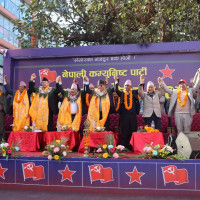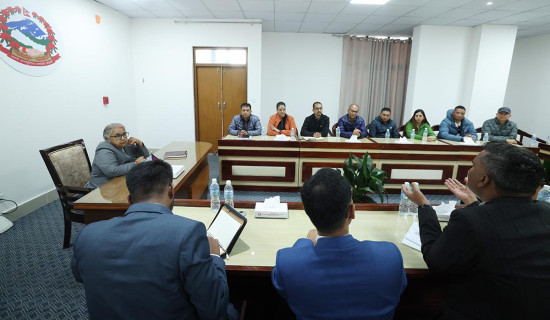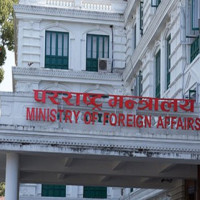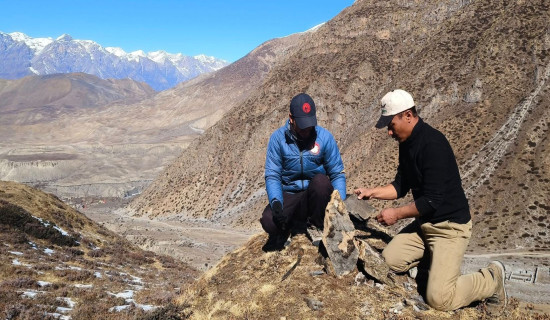- Monday, 1 December 2025
Decades on, demand for a slaughterhouse goes unheeded
BY SANTOSH SUBEDI,Kaski, Oct. 16: Kaski is one of the districts with the highest meat consumption in Nepal. Meat entrepreneurs have said that thousands of kilograms of goat, chicken, buffalo, and lamb meat is sold daily. Among these, chicken has the highest demand in the district.
However, despite the high demand, consumers in Kaski, particularly in Pokhara Metropolitan City, are still not able to access hygienic meat due to the lack of a proper slaughterhouse.
Entrepreneurs believe that if the metropolitan government enforced a rule requiring meat to be sold only after being processed at a certified slaughterhouse, and implemented this strictly, it could be effectively carried out.
The Meat Inspection and Slaughterhouse Act of 1998 also appears to be limited to paper, without any meaningful implementation. In 2011, the then Pokhara-Lekhnath Municipality even issued guidelines to improve the meat market. However, those directives have neither brought any visible improvements nor have they been followed.
Even today, it is common to see meat being cut on open tables, with vegetable shops on one side and meat shops on the other. Such unhygienic practices mean that consumers are unable to get quality meat. Currently, around 500 meat shops are registered with the Pokhara Meat Entrepreneurs’ Association. According to the association’s president, Lokraj Sharma, it is unfortunate that despite the large number of meat shops in Kaski, there is no proper slaughterhouse.
“Our association has repeatedly appealed to the metropolitan government. It has been heard that the municipality backed off at the final stage of land selection due to local opposition,” he said. “It is very costly for individual entrepreneurs to set up such facilities. Therefore, local bodies and the government need to create proper rules. Only then will the construction of a slaughterhouse be feasible.”
While a modern slaughterhouse may not be as necessary for poultry, Sharma emphasised that it is essential for goats and buffaloes. He also stated that some meat sellers prefer to continue operating in the traditional way, but consumers need to actively seek out properly managed shops.
“Whether meat is cut at a nearby shop or elsewhere, people will still go and buy it. Consumers also need to be more aware,” he added. He said that inspections should not be limited to seasonal periods but carried out consistently throughout the year.
Ram Bahadur Paudel, president of the Civil Society, expressed concern that despite continued demands for a modern slaughterhouse, the concerned authorities have remained silent.
“Since the time Pokhara was declared a sub-metropolitan city, we’ve been demanding a separate slaughterhouse facility. The metropolis should deploy a study team and move the project forward. Consumers are still unable to get hygienic meat,” he said. He further emphasised that proper attention must also be given to meat hygiene as part of building a clean and healthy Pokhara.
Kapilnath Koirala, president of the Consumer Forum Gandaki, said that even though regulations mandate that animals must be slaughtered in proper slaughterhouses, this is not being followed. According to the Animal Slaughterhouse and Meat Inspection Act 1998 and the Rules 2000, animals must not be slaughtered in front of other animals, must be inspected by veterinarians beforehand, and the location must have adequate water facilities.
Even in terms of slaughterhouse construction, the technical guidelines set in 2007 have not been followed during site selection. Clause 3(g) of the Slaughterhouse Directive clearly states that slaughterhouses must not be located near forests, residential areas, or densely populated settlements. “It’s been 27 years since the law came into effect, yet it still hasn’t been implemented. We’ve repeatedly demanded timely action,” Koirala said.
Despite repeated requests from citizens and consumers for a slaughterhouse in Pokhara, no significant steps have been taken. Pokhara Metropolitan City Mayor Dhana Raj Acharya said that a call had already been issued for the construction of a slaughterhouse. He said that it would be built using a new PPP (Public-Private Partnership) model and modern technology.
“The previous plan couldn’t move forward due to land disputes. Now we’ve already made the call, and work will begin immediately after Tihar,” he stated.
He also pointed out that there was a misunderstanding among some people regarding what a slaughterhouse entails.
“As soon as people hear ‘slaughterhouse,’ they assume it’s about waste and dirt. But slaughterhouses can be built within city limits, just like party venues. Our plan is to build it in such a modern model. Construction will begin soon,” he assured.

















